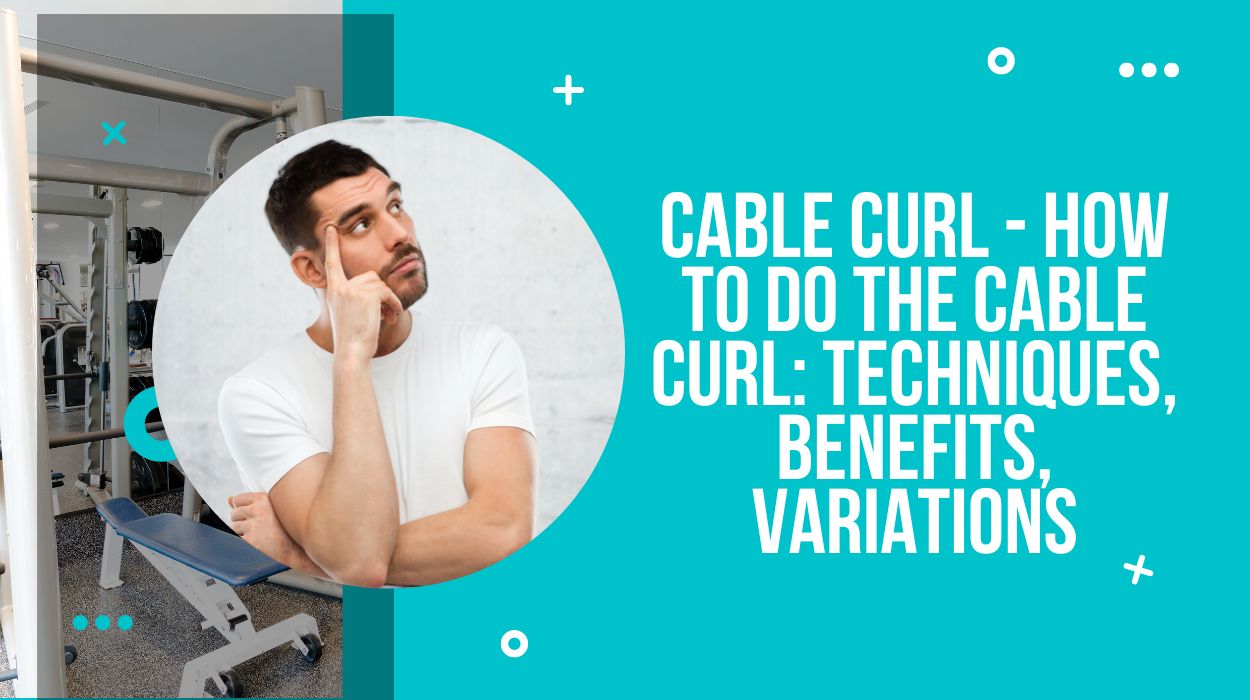There are far too many exercises that could help you build your biceps. One of such isolated exercises is the cable curl.
This workout exercise targets and activates the biceps brachii. At the same time, it works on your core and stabilizes your muscles. Experts suggest that a cable curl is an effective option for somebody who wishes to build and shape their bicep muscles.
You can finish your bicep training session with this exercise for comprehensive results.
| Utility | Basic |
| Mechanics | Isolated |
| Force | Pull |
Muscles Worked by the Cable Curl

Similar to other exercises, cable curl targets two major muscle groups.
Primary Muscle:
- Bicep brachii
Secondary Muscles:
- Trapezius
- Brachialis
- Anterior deltoid
- Levator scapulae
- Brachioradialis
- Core Muscles
It goes without saying that, majorly, cable curl targets your bicep branchii muscle. This muscle helps develop the strength of your bicep. It also helps in avoiding injuries or strains while conducting everyday chores, like picking up things.
When you curl your arm, this muscle flexes the elbow. The scapula is connected with the radius of the forearm with this muscle.
Other than that, other stabilizing muscles assist in the upper back and shoulder while performing cable curls. These are known as anterior deltoid, the levator scapulae, and trapezius.
Benefits of Cable Curl
Bicep forms a major part in forming an appealing appearance of the upper arms. They are appreciated by all genders. The cable curl can help you get that physique by building your biceps.
But are large and strong biceps the only benefit of the cable curls? Not at all. The advantages of the cable curls are manifold, like the following:
Isolated Exercise
When you integrate compound exercises into your workout routine, it might not help you build a specific muscle. For example, if you want to build your biceps and have strong upper arms, you will need isolated exercises, like the cable curl.
The cable curl targets the biceps brachii. It trains the muscle in insolation so that you can get better and faster results.
Involves Stabailziing Muscles
Along with the bicep muscle, the cable curl exercise also works on the stabilizing muscles in the upper back and shoulders.
In a way, you can train your upper body with this exercise, enhancing your progress.
More Tension on the Muscle
While performing cable curls, you feel a constant tension on the biceps. The difficulty remains stagnant during the entire range of motion.
Due to this, you feel a build-up in your bicep muscle, regardless of the motions. Furthermore, this helps in getting faster and more defined results.
Variety
Are you tired of doing the same exercise every day? Well, you can add a bit of variety to it by adding the cable curl to your routine.
How to Perform the Cable Curl?
Generally, cable curl is a simple exercise that you can perform daily. But sometimes, beginners tend to change their form and technique while doing it. This can reduce the chances of gaining stronger biceps.
If you want the cable curl to work properly on your bicep muscles, you must maintain a correct form throughout the exercise. For reference purpose, read the following step-by-step instruction for performing cable curl:
- Stand in front of a cable machine with a wide athletic stance. Ensure that your legs are not too narrow or too wide.
- Hold the handle with your hands and try to squeeze it as much as possible.
- Keep your head high, and do not look in a downward direction.
- Without moving your wrists, curl up the handle.
- With slow and controlled motions, bring the handle to your biceps peak.
- Hold it for a second and lower your arms.
- Breathe out while curling the cable weight and breathe in a while lowering it down.
- Once you get a full stretch, bring it back up.
- Repeat the procedure.
If you are new to this, you can use a lightweight setting in your cable machine. Moreover, you can also use one arm at a time to reduce the overload.
On the other hand, if you have been practicing this exercise for years, you can increase the weight setting. There are several other variations for this exercise that are explained further in this article.
Common Mistakes to Avoid While Performing Cable Curl
Cable curl is a rather simple exercise with little to no scope of mistake. But as mentioned earlier, beginners with a compromised form might not understand the technique. This can lead to a wrong form, leading to no results.
The following are some of the most common mistakes made while performing the cable curl:
Wrong Body Posture
You must be aware of your body posture while doing the cable curls. Keep your knees loose and not too stiff. Keep a distance of one foot between your legs. Keeping it too wide or too narrow will come in the way while doing this workout. You can also keep them parallel to your shoulders.
Do not roll down your shoulders. Retract them while looking straight. Any discrepancy in this body posture will not bring perfection to this exercise.
Lastly, do not stand too far off from the cable machine. This will cause flexion of the shoulder muscle that is not required in this exercise.
Jumping while Curling
We have seen several people jumping while curling the cable. If you are one of them, we recommend you not to do that.
By doing so, you are diverting the tension from your biceps. Such a motion will not help you build biceps. Keep a restricted body movement while curling and lowering the cable weight.
Half Range of Motion
When you curl the cable, it is important that you go for a full contraction. With a half contraction, your bicep will not get as activated. Moreover, your arms must also stretch all the way down while lowering.
Exaggerated Grip
The grip you maintain on the bar in a cable curl machine is important. Even though there are no wrong grips, but you must understand the difference.
With a close grip, you train the long head of the biceps. This leads to more muscle mass.
At the same time, it might restrict you from producing force while curling.
When you hold it with a wipe grip, your shoulders get activated. This helps you curl more comfortably.
You can choose any one as per your comfort level. But before doing so, understand the effects that your grip might cause.
Wrist Position
Your wrists must always remain neutral or slightly extended while curling. If you keep on changing its position, the tension will remain in your arms. Only when the wrists are neutral or slightly extended, you feel the tension in your biceps.
Sets, Reps, Programming Recommendations for Cable Curl
Bicep exercises are not meant to be done every day. Even when it comes to cable curl, we recommend you do it thrice a week.
Start with one set of twelve reps each. Once you are comfortable with it, you can increase the sets.
Variations of Cable Curl
If you feel that a simple cable curl is not challenging enough, you can try a hand at the following variations:
One-arm Cable Curl
This exercise is exactly the same as the normal cable curve. The only difference is that you concentrate on one arm at a time. You keep the other free hand behind your back, in a locked position.
The main benefit of this variation is that your arms and biceps get more rest. This leads to the more and better emphasis laid on them while curling.
Reverse Grip Cable Curl
In this variation of the cable curl, you reverse your grip on the handle.
This helps in strengthening the wrist joint. Moreover, it increases the muscular strength in the biceps.
High Cable Curl
This variation targets and activates the short inner head of the biceps. Furthermore, it helps in increasing the thickness and width of the biceps.
It also focuses on stabilizing muscles.
Cable Rope Hammer Curl
This will turn out to be useful to you if you are into complex weightlifting exercises. It is performed with a neutral grip and targets the biceps from all angles.
Moreover, the neutral grip increases grip stability and wrist strength.
Safety & Precautions for Cable Curl
The following tips can be of your service while doing cable curls:
- Hold the handle with a tight grip.
- Do not stand too far off from the cable machine.
- Avoid moving your shoulders while curling. Only the lower portion of your arm must be in motion.
- Your elbows must be tucked by your side at all times.
- Keep your head held high.
- Hold the curl for a second and maintain slow and controlled motions.
- Do not change your grip in the middle of a set.
- Avoid doing partial contraction.
- If you have a wrist injury, do not perform this exercise.
Alternatives of Cable Curl
Do you want to try something beyond the regular cable curl? The following alternatives might be useful to you:
- Plow Pose
- Chin Up
- Handstand
- Bicep Stretch
- Superman Exercise
- Cable Crossover
- Barbell Military Press
- Tempo Bicep Curls
- Bicep Curls with EZ bar
- Miniband Curl Extension


